skip to main |
skip to sidebar
I dont know why I dont feel the urge to take part in all the food events that take place in the food blog world. I ought to, but I dont. I dont know what it is - but maybe the sheer number of events is overwhelming, maybe my imagination isnt up to the task, maybe I dont want to take part in one and not another... because believe me, they're all interesting events and I always, ALWAYs follow the various submissions because they're so fascinating. I just dont contribute. It could be that the task of putting myself up there with all the fabulous bloggers is daunting. Or maybe I'm just too damn lazy. On the evidence of my life thus far, that is probably the most likely reason.
But when the lovely, funny, ever-so-talented Vaishali of Happy Burp dropped by my blog to kick my ass subtly and politely, I had to get off it - if only to provide her with the target - and make something for the event she was hosting. That's Jihva for Potato. Perfect timing - the ass-kicking and the ingredient both. After all, who doesnt love a potato (unless it is of the human couch-type variety - and I can say this without guilt now that I'm no longer one myself... no longer sitting on Vaish's favourite target.) :)
So here it is, my entry for Jihva for Potato, inspired by a Moosewood classic low-fat low-calorie recipe. It's amazingly tasty for not being fried AT ALL, and it's great as a snack with a tomato relish, sour cream or your favourite topping. It even makes a yummy filler for a pita bread sandwich with hummus and/or tahini and salad.

PS. No step-by-step photos because my bl**dy cannibal card reader deleted them when I was trying to download! ARRRGH. Have to get a better one...
Recipe for: Low-calorie potato patties

Ingredients:
2 large potatoes, peeled and cubed
2 cloves garlic, minced
1 salad onion or scallion, minced fine
2 tbsp parsley or coriander, chopped fine
1 tbsp fresh dill leaves, chopped, or 1 tsp dried
1 egg white
2 tbsp non-fat yogurt or sour cream
1 tsp paprika
1 tbsp olive oil
2 cups fresh fine bread crumbs (use French bread if you like, to cut down even more on fat)
1 tsp red chilli powder (optional)
Salt and fresh ground black pepper to taste
Method:
1. Put the potatoes and garlic in a saucepan and pour in water till the potatoes are covered fully.
2. Bring to a boil, then cover and simmer for 15-20 minutes or till the potatoes are cooked. Drain the potatoes (save the stock for soup).
3. Place the minced scallion, parsley/coriander, dill leaves, yogurt/sour cream, paprika, egg white, 1/2 cup breadcrumbs and the potatoes in a large bowl and mash thoroughly by hand. (Using a food processor would make it too gloopy.) Add salt and pepper to taste (and red chilli powder if using) and mix well.
4. Heat the oven to 180C. Pour 1 tbsp olive oil on a baking sheet and spread it using your hands. This will also oil your hands so that the sticky dough will be easier to handle.
5. Form round patties from the dough and dip each one in the breadcrumbs, making sure to coat both sides thoroughly. Place on the oiled baking sheet.
6. Bake at 180C for 15 minutes, then turn the patties over and bake for another 15 minutes, or till the edges turn golden brown.
7. Serve warm or at room temperature with a selection of toppings as a snack or appetizer.
The first cookbook I was gifted was from my best friend when she was a reporter - for some reason she got the book (Rohini Singh's The Wonderful World of Indian Cookery) at a press meet - I imagine it was so she could review it, but I'm not certain. Whatever, when she was done with it, I asked to have a look at it.
It wasnt out of interest in cooking, because I didnt care to spend time in the kitchen at that point in my life. I suppose I was just curious to have a look at the inside of the book. But as I flipped through it, one photo in particular caught my fancy, and that was of a dish of rajmah (red kidney beans). (My camera doesnt do it justice, but it was the only way I could take the photo without obliterating the page with the flash reflection!)
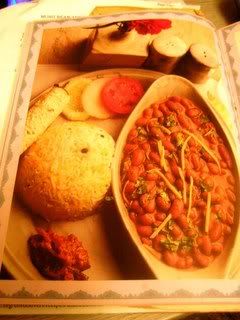
I dont know if it was the hungry look on my face or what, but right there and then my friend scrawled an inscription in the book and handed it over to me. What she had written was: Here's hoping you develop the patience and have the time to cook.
Looking back on that, I dont think I ever, even for one moment, imagined that one day I would find cooking an interesting, pleasurable and rewarding experience. Or that I would have a food blog. But here I am, and I think it was with that rajmah recipe that I made my first proper entry into the kitchen. Of course at that time I doubt I was even aware of the existence of canned food. I'm not sure that tinned food was available in the shops in India. Maybe it was, but I must have walked right past them without their presence ever registering. Tinned food was just NOT done in our home, or in the home of anyone I knew. It's only after coming to the UK that I've actually conceded the usefulness of some tinned food. Sometimes. Mainly beans.
Anyway, the whole recipe was done from scratch - soaking the beans overnight, cooking them in the pressure cooker and so on. The first few times I made rajmah was exactly as per Rohini Singh's recipe, nose pressed to cookbook - ok, not literally, but the liberal stains and dried sauce marks on the page (no, I'm not going to show anybody that page - it's not a pretty sight!) testify to my having the book open to the page and VERY close to my cooking arena!
After all that rambling, let me get to today's recipe. Rajmah made my way, with *gasp* tinned pre-cooked red kidney beans! Let me tell you, it tastes just as good and saves all the trouble of soaking and waiting and checking to see if the rajmah is sitting in the pan like hard little red stones, or whether it's cooked to the right softness.
I've found that the "raw" smell of ground uncooked onions never really disappears from any sauce, unless oodles of oil is poured in to literally fry the paste and thus get rid of the smell. But then I discovered that if you grind other items with the onions - coriander leaves and ginger, for example, the nasty raw smell never appears in the first place. So that's how I made the sauce for the rajmah.
Recipe for: Rajmah with coriander

Ingredients:
1 cup fresh coriander leaves, chopped
2 medium onions, roughly chopped
2 large tomatoes, blanched, skinned and chopped fine
1 tin of kidney beans (or one generous cupful)
2" piece of ginger, chopped
5 green chillies (or to taste)
1 tsp coriander powder
1 tsp cumin powder
2 cloves garlic, minced
1 tbsp oil
1/2 tsp turmeric powder
1/2 tsp garam masala or 1 tsp chole masala
1/2 cup water
Salt to taste
2 tbsp heavy cream (optional)
Fresh coriander leaves for garnish
Thin matchsticks of ginger, deep-fried, for garnish (optional)
Method:
1. Grind the ginger, coriander leaves, green chillies and onions in a mixie.
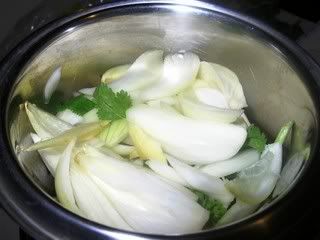
Add a little water while grinding, if required, to make a smooth paste. Reserve.
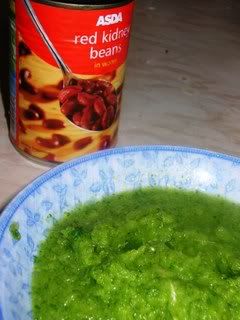
2. Blanch the tomatoes in hot water for a few minutes, then peel the skin. It will come off easily.
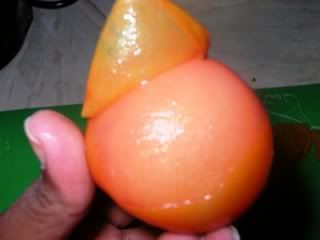
Chop the skinned tomatoes finely and reserve.
3. Heat the oil in a large pan and fry the minced garlic for 15 seconds or so.
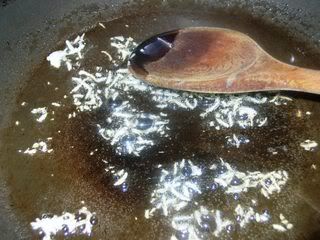
4. Add the reserved onion-coriander paste and fry on high heat, stirring, for about 3 minutes.
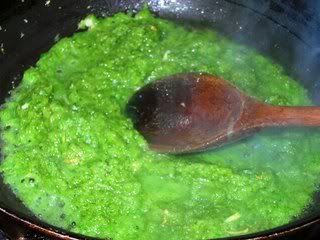
5. Add the chopped tomatoes and fry on high heat for 3 minutes. Add 1/2 cup water and lower the heat, stirring once in a while, till the tomatoes cook down to a thick sauce.
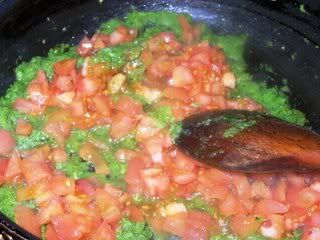
6. Now add the coriander powder and cumin powder. Stir well.

7. Let the sauce cook for another 3-4 minutes, then add the kidney beans, reserving a spoonful. Mash this and add to the sauce to thicken the rajmah.

8. Stir in the salt and garam masala/chole masala and let the rajmah bubble for 5 minutes or so. Stir in the cream if using, garnish with coriander leaves, and serve hot with plain boiled rice, papad and pickle for a satisfying meal.
I got the original recipe for this cake from http://www.eggless.com and appropriated it for my own use, as it were, halving the ingredients to make a smaller cake and substituting others to make it lower in fat if not in sugar. The cake tasted quite nice, but the texture was heavy, with a dense crumb.

I assume that was because of the lack of eggs to make the batter light, but I could be wrong. Perhaps it was because I used low-fat yogurt instead of sour cream.
In any case, I'll be trying out more eggless cakes from now on because I've just bought a book published by the Bhaktivedanta Book Trust - "The Book of Eggfree Cakes". The author goes by the somewhat unlikely name of Cintia Stammers - not that her name is of any consequence, as long as the cakes turn out well.

The reason I say I'll be trying out the recipes in the next couple of months is because my mother's arriving next week - and since she does not eat eggs in any form, she'll be the perfect guinea pig for the eggless cakes I bake! Watch this space. Or, more accurately, watch this blog! :)
Recipe for: Eggless almond cake
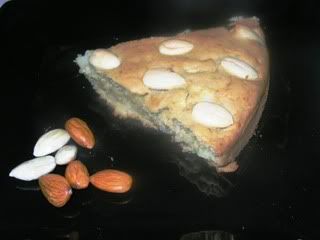
Ingredients:
1-1/4 cups white self-raising flour
1/2 tsp. baking powder
1/4 cup butter
1/2 cup caster sugar
3 tbsp fat-free yogurt (I used Greek-style)
1/2 cup milk
1/2 tsp almond essence
1/4 cup flaked almonds
15-20 whole almonds, de-skinned
Non-stick spray to grease the cake pan
Method:
1. Preheat the oven to 170C. Grease a 6-inch round cake pan.
2. In a mixing bowl, cream the butter with the sugar until light and fluffy.
3. Sift the flour and baking powder into another bowl. Mix the yogurt and the milk together in a small jug.
4. Add 1/3 of the flour mix to the creamed butter and beat in thoroughly. Then pour a third of the milk mixture and beat it in. Finish up the remaining flour and milk mix the same way till you get a fairly thick batter. Make sure you beat well after each addition.
5. Now stir in the almond essence and the flaked almonds.
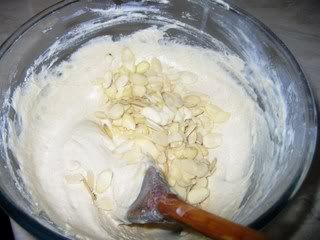
Pour this batter into the greased baking tin.
6. Arrange the whole almonds in a pretty pattern over the batter, pushing each almond in lightly with a finger tip but without making them sink in to the batter.
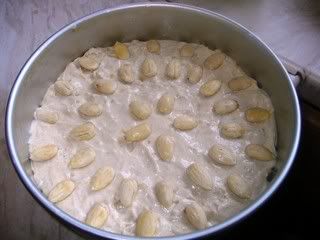
7. Bake for an hour or till the cake tests done. The almonds on top should be a light brown.
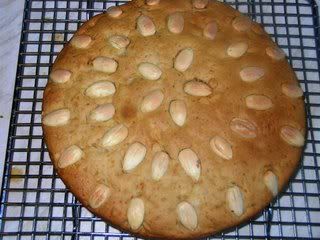
8. Turn the cake out onto a wire rack and let cool completely before slicing.
Beans, beans the musical fruit
The more you eat, the more you toot
This ditty has one major error and one major truth - the error is that beans arent fruit and the truth is that yes, they DO make you "toot"! Which is why we Indians tend to use ginger - especially in bean recipes - to aid digestion and reduce the tooting involved.
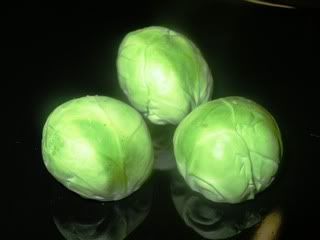
However, beans arent what I used to make today's dinner - it was brussels sprouts, those little baby cabbagey vegetables that make people go "yum" or "yuck" with no real middle ground between like and dislike. I'm firmly in the "yum" camp and Pete just as firmly belongs to the "yuck" camp. Sometimes I really wonder what it is that keeps us together because we're SO unalike in major ways - starting with food!
Anyway, this sambar was entirely and only for myself. Since I was cooking with sprouts, something Pete wouldnt touch if you put him before a firing squad, I made it as spicy as I could possibly want. But as sprouts are pretty much up there with beans in the tooting department, I decided to add a generous tablespoon of grated ginger while making the sambar.
Now, ginger is not an ingredient that goes in any sambar I've made thus far and I wasnt sure what effect it would have on the taste. I neednt have worried - the sambar was delicious! I used more tamarind than I normally would, but it went well with the sprouts and ginger, methinks, gving it a sharp piquancy.
I paired the sambar with plain steamed rice, pan-roasted potatoes, a simple tomato-cucumber salad and microwaved appalam (papad) and considered myself well and truly pampered.
Oh, and I dont mind adding that thus far, not a single toot has announced its presence!
Recipe for: Gingery brussels sprouts sambar
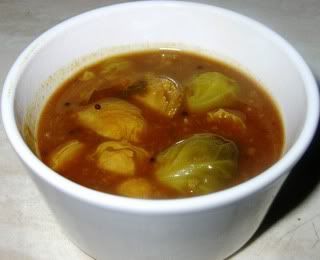
Ingredients:
1 generous cup cooked and mashed toor dal
10 brussels sprouts, washed, trimmed and quartered
1 tbsp tamarind paste, dissolved in 4 cups hot water
1 tbsp ginger root, grated
1 tsp oil
pinch asafoetida powder
5 green chillies or to taste
2 htsp sambar powder
Salt to taste
For tempering:
1 tsp oil
5-6 fresh curry leaves
1 tsp mustard seeds
1 tbsp chopped coriander leaves for garnish
Method:
1. Heat 1 tsp oil in a saucepan. Add the asafoetida powder and green chillies and stir-fry for 30 seconds.
2. Add the quartered brussels sprouts and stir fry on high heat for a minute, then add the ginger root and fry for 30 seconds more.
3. Add the sambar powder and mix, then pour in the tamarind water.
4. Bring the mixture to a boil, then reduce the heat to medium heat and simmer till the sprouts are cooked.
5. Now add the mashed toor dal (mixing it with 1/4 cup hot water first to make a pourable paste) and stir it in well. Add salt to taste.
6. Let the sambar boil for 5 minutes.
7. To do the tempering, heat 1 tsp oil in a small pan. Add the curry leaves and mustard seeds, cover the pan. When the mustard seeds have finished popping, pour it on the sambar.
8. Mix well. Garnish with chopped coriander leaves.
If possible, let the sambar sit for 2-3 hours to let the flavours develop. Bring to a gentle simmer again, before serving hot with plain rice and any vegetable curry.
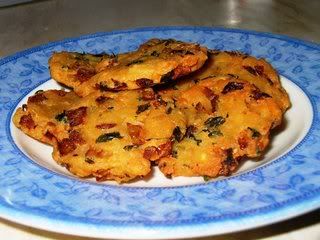
Yep, they look nice, dont they? :) They WERE nice. Ever since I saw the recipe for maddur vada on Latha's blog a few weeks ago, by sheer chance (I'd googled "maddur vada"), I'd been hankering to make them. They're simple to make, and really best eaten fresh while they're still fairly crisp. I personally liked their chewy texture a day on, but I think that could just be me, a one-woman fan club.
I used the same ingredients as specified in Latha's recipe, but made a small addition of my own - urad dal that had been soaked for 2-3 hours. I think I had a vague of idea of the really really scrummy "Tirupati vada" that I'd eaten long ago, before the Tirupati laddoo became the only prasadam (holy offering) available. The Tirupati vada was dark brown, very chewy, and had urad dal in it. I havent a clue about the rest of the ingredients in that prasadam - all i remembered was the texture and the fact that there was urad dal in it.
The urad dal DID make a difference to the maddur vada - if only in taste. I'm quite glad I made the addition!
Recipe for: Maddur vada
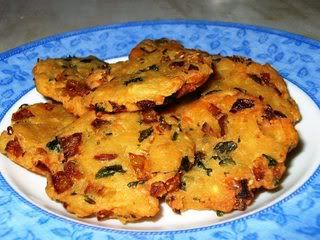
Ingredients:
1 cup fine semolina
1/2 cup rice flour
1/4 cup plain flour
1 tsp red chilli powder
5 tbsp hot oil for kneading
2 onions, finely chopped
1/2 cup urad dal, soaked for 2-3 hours
1/2 cup coriander leaves, chopped
10-15 fresh curry leaves, chopped
Fresh green chillies to taste, minced
Salt to taste
Oil for deep frying
Method:
1. Heat the oil in a deep pan.
2. Put the rice flour, plain flour, semolina, red chilli powder and salt in a bowl. Add 5 tbsp hot oil and and mix well with a wooden spoon.
2. Add the chopped onions, urad dal, coriander, curry leaves and chillies.
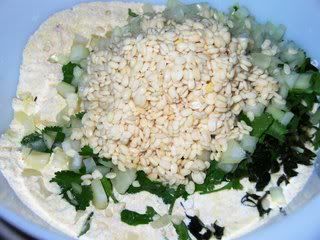
Mix with enough water to make a rough dough. Use your hand for this.
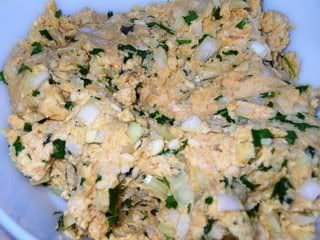
3. Take a small ball of this dough and flatten with your fingers (or use a glass, greasing its bottom well) on a non-stick sheet.

4. Drop into hot oil and deep fry on medium-high heat until golden brown.
5. Serve hot with any dipping sauce.


























